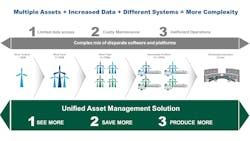Automation and Green Assets: Shine More Light on Renewable Energy Operations
As the green energy revolution continues to gain momentum, more and more players—from traditional power providers to entirely new companies—are getting in the game.
But regardless of their starting point, all stakeholders are quickly learning one thing: they cannot operate a modern renewable fleet in the same manner as a traditional coal or gas-fired power generation plant. No longer are operations and maintenance teams responsible for two or three critical assets generating electricity. In today’s wind and solar facilities, a team may instead be responsible for hundreds, or even thousands of assets spanning a wide geographical area.
On a wind farm, for example, the operations team may have hundreds of turbines all contributing to the total generation capacity. At any time, due to maintenance or other factors, a percentage of those assets may not be running.
But, unlike in a traditional generation facility, failure of a few renewable power generating assets is typically not critical. Moreover, due to supply chain, procurement, and capability factors, the hundreds of different renewable assets the team operates were likely supplied by a variety of disparate original equipment manufacturers (OEMs).
The benefits of a more distributed power generation system are obvious—operations and maintenance can work more effectively when the loss of a few assets is not a catastrophic event. However, this new dynamic creates complications as well. Because each OEM provides a proprietary automation system for its assets, renewable energy producers can quickly end up with a complex mix of disparate systems, each with its own control strategies and limitations. This ambiguity makes it difficult to collect data and maintain data integrity, which in turn complicates operations and maintenance protocols.
The most successful power producers are navigating this complexity by embracing a boundless automation vision with fit-for-purpose renewable asset monitoring software. Today’s most advanced renewable asset monitoring solutions connect varying OEM system data into an integrated renewable energy ecosystem, eliminating silos to seamlessly move data from the field, across the edge, and to the cloud (Figure 1).
Figure 1: An integrated renewable energy ecosystem eliminates data silos to seamlessly move data from the field to the enterprise.
Renewable assets are easier to secure, support, and connect to the grid when managed by OEM-independent applications. However, with a wide variety of software solutions on the market and more arriving seemingly every day, it can be difficult to select the best option.
But by focusing on key qualities—more intuitive and flexible operations and maintenance, and improved support and scalability—energy producers can much more easily select a solution that will meet their needs across the lifecycle of their green energy generation and storage assets.
Intuitive operations from a single pane of glass
Because renewable assets typically run with marginal profitability, acceptable performance requires peak efficiency. Quickly interpreting what is happening on each asset, understanding the situation, and then making a fast decision about what to do is therefore essential to optimizing operations. These efficient operations are difficult to accomplish when operators must also manage the ambiguity of working in multiple systems that are similar, but not the same.
Even in a single facility, operators often need to work with many different systems, each with varying levels of available data. Each system may have a unique interface, distinctive dashboard, and even require different clicks and keystrokes to access critical data. Every operator needs to understand each system well enough not only to work within it, but also to transition between multiple interfaces quickly and accurately. In addition, operators typically manage more than a single site. The problems that come from managing different sources of data are quickly multiplied as the company grows its fleet size or expands its renewable asset portfolio (Figure 2).
Figure 2: Applying a single, OEM-independent asset management solution decreases complexity, enabling owners and operators to see more data, save on maintenance costs, and produce more energy.
OEM-independent renewable asset management solutions eliminate the data integrity problems stemming from disparate solutions by aggregating all automation systems together into a single, seamless interface. Teams can monitor and operate any asset across a farm, fleet, or enterprise from a unified intuitive dashboard. Personnel can much more easily interpret what is happening with each asset, and then make better decisions about how to respond and prioritize action.
The best solutions also empower operators and technicians to click through assets via the dashboard to gain actionable insights so they can manage resources for peak performance. An operator can quickly identify and perform an action to resolve an alarm, then implement a mitigating strategy to prevent the incident from happening in the future.
Granular control offers more flexibility
Renewable assets typically have hundreds of parameters that can be useful to help a team make the most of its operations. The right data, available to the right person from anywhere at any time, can help teams improve operations by tracking and trending performance and reliability data. The same data can even be used to test and develop new strategies by utilizing the power of advanced analytics and machine learning. However, though the parameters to provide this data are generated by the assets, they are typically trapped within the systems themselves.
For example, a wind farm might experience replicating failures among many assets on a single site, or they might not get the yield the team expects because turbines have been throttled back on certain parameters to preserve bearing life instead of maximizing performance. Or a team may need to recalibrate when changes impact wind flow—such as when a new building is constructed nearby or when other turbines disrupt the air flow.
By looking at available data, teams can troubleshoot problems or implement advanced control algorithms to tweak and tune operation so they can get the most from assets in any given environment, while still operating within safe parameters. However, this is only possible when the necessary data is accessible.
The best asset management solutions solve this problem by connecting to nearly any renewable energy asset on the market directly out of the box, expanding dozens of available parameters to hundreds. Not only is this data useful for driving better performance from on-site assets, it also provides a wealth of condition monitoring data, helping maintenance teams keep track of the health of assets, and allowing them to intervene before pending problems become failures (Figure 3).
Figure 3: Put control of operations and maintenance back into the hands of owners and operators with an asset management solution that provides a unified view of renewable operations from a single pane of glass.
Fit-for-purpose solutions offer improved performance and scalability
While many asset management solutions offer additional visibility of operating parameters, the best solutions are not only robust, but scalable. Many organizations choose to implement asset management on the local level, selecting a single problem asset for better insight to improve its performance. If the team chooses a scalable, fit-for-purpose solution it can then expand that same system to cover an entire fleet of assets the team wants to optimize. From there, they can expand across the farm or even the enterprise—managing multiple fleets using the same system, still from a single dashboard.
This flexibility comes from unified OEM-independent renewable energy platforms built on a heritage of global power industry experience. Automation providers with a long history working in power generation build their solutions with a foundation in industry expertise that simplifies connectivity and operation. The most robust solutions connect seamlessly to nearly every type of available asset, and they can be used to interconnect a wide range of the software solutions and technology products needed to manage a power generator’s entire portfolio. An integrated ecosystem of solutions built on energy industry expertise offers a more secure and intuitive architecture, while providing peace of mind because the asset management solution will be supported well into the future by an established network of partners.
Securing the green energy future
The renewable energy market will only continue to expand, and as it does, so too will renewable providers as they expand their portfolios and footprint to deliver the service their customers expect. The companies that best navigate that expansion will be the ones that can do so without creating a complex web of interconnected disparate systems, trapping data in silos across the organization.
Operational efficiency depends on operators who can react quickly and confidently to deliver the best performance across their facility, the fleet, and even the enterprise. Choosing the right asset management tools to empower those operators is a simple step any organization can take to better secure its competitive advantage in a rapidly evolving market.
(All figures courtesy of Emerson)
About the Author
James Fraser, Vice President of Renewables, Emerson
James Fraser has almost 25 years of automation experience in the power industry. As vice president of renewables, James is responsible for leading the continued development and execution of Emerson’s renewable strategy. His focus is driving the global growth of Emerson’s expanding renewable capabilities through the increased sales of software and automation technologies of the Ovation Green Suite of solutions--and quality implementation of customers’ clean energy portfolios—including wind, solar, hydro and energy storage projects.
James has a bachelor’s degree in Control Systems Engineering from the University of Sheffield and is currently pursuing a Master of Business Administration at the University of Cranfield.




